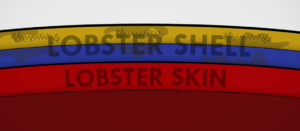No photoshopping! It’s real, and it’s spectacular. And very, very rare. How did it get that way?
Let’s deal with the burning questions first. Yes, they taste the same as regular lobsters. Yes, they still turn red when you boil them. In nature they’re about 1 in 2 million. If you breed a male and female blue lobster, the baby lobsters come out blue. And if you’re dying to have one for your personal aquarium, well, some guy did try to sell one on Ebay for $500 …. but even if you have a regular ol’ pet lobster, you can turn it blue just by changing its diet! (Read on…)
Blue lobsters are rare, but even more rare are the naturally red ones (before boiling – 1 in 10 million), yellow (1 in 30 million), orange and black calico (1 in 30 million) and split colored (1 in 50 million) and rarest of all the white/crystal/albino only 1 in 100 million. [link]
This split-colored lobster gets more intense every time he molts!
Or maybe I should say s/he since most of the split-colored lobsters are hermaphrodites.
Now, about the coloring:
There’s a red pigment called astaxanthin (we’ll call it asta for short) that lobsters get in their diet.
The lobster skin (“epidermis”) contains the free/unbound asta, making it red. The main part of the shell (“cuticle”) contains a big protein complex called alpha-crustacyanin. Asta bound to alpha-crustacyanin turns blue. The outermost layer of the shell (“epicuticle”) contains a different protein called crustochrin. Asta bound to crustochrin is yellow.
When you look at a normal live lobster, you look through all three colored layers and it looks like the typical dark, mottled, muddy color of a live lobster. When you boil the lobster, the proteins unbind from the asta and the lobster goes back to the color of the free asta, which is red.
How do those blue lobsters happen? Various webpages state with authority that it’s caused by a genetic mutation causing overexpression of crustacyanin. But I cannot find a single reference or documentation to support that.
You can make a “dietary-blue” lobster by feeding it less asta. I suppose yellow lobsters have some sort of mutation that screws up their crustacyanin gene, eliminating the blue.
The crystal/white lobsters are still a mystery to me. They get the same diet as normal lobsters yet it doesn’t color the skin red. Perhaps they have a deficiency in the asta uptake mechanism, if there is one.
Alpha-crustacyanin was purified from ground-up lobster shells back in 1948. It’s a complex of 16 asta molecules along with 16 small protein subunits. There are two genes involved – CRTA and CRTC. The CRTC group includes type A1, C1 and C2 and the CTRA group includes type A2 and A3. (C1 and A2 predominate.) One subunit from each group combines to form a dimer (for instance, C1 and A2); each heterodimer, no matter what the combination, is called beta-crustacyanin. Eight beta-crustocyanins bind together with the 16 asta molecules to form the whole shebang, alpha-crustacyanin. [link]
Would you believe the alpha-crustacyanin complex was crystallized in space? Your tax dollars at work, folks.
Astaxanthin is actually pretty interesting by itself. Salmon and flamingos also get their pink color from this molecule. It’s related to beta-carotene, the orange color in carrots, and lycopene, the red color in tomatoes. There are over 600 related compounds that produce different colors. Asta is a powerful antioxidant that cures cancer, baldness and hemorrhoids (just kidding). But it is being tested for pharmaceutical, culinary and cosmetic purposes.
Yes, ASTALIFT. Because it sounds better than, you know, LOBSTERFACE. Or Creme de Carapace.
Amazingly enough, the lobster genome is estimated to be at least a billion base pairs bigger than the human genome. (Why? No idea…) The Gloucester Marine Genomics Institute is collaborating with a biotech company to sequence the genome of the Homarus americanus lobster. Hopefully they are including samples of the various colored lobsters as well. Stay tuned!







